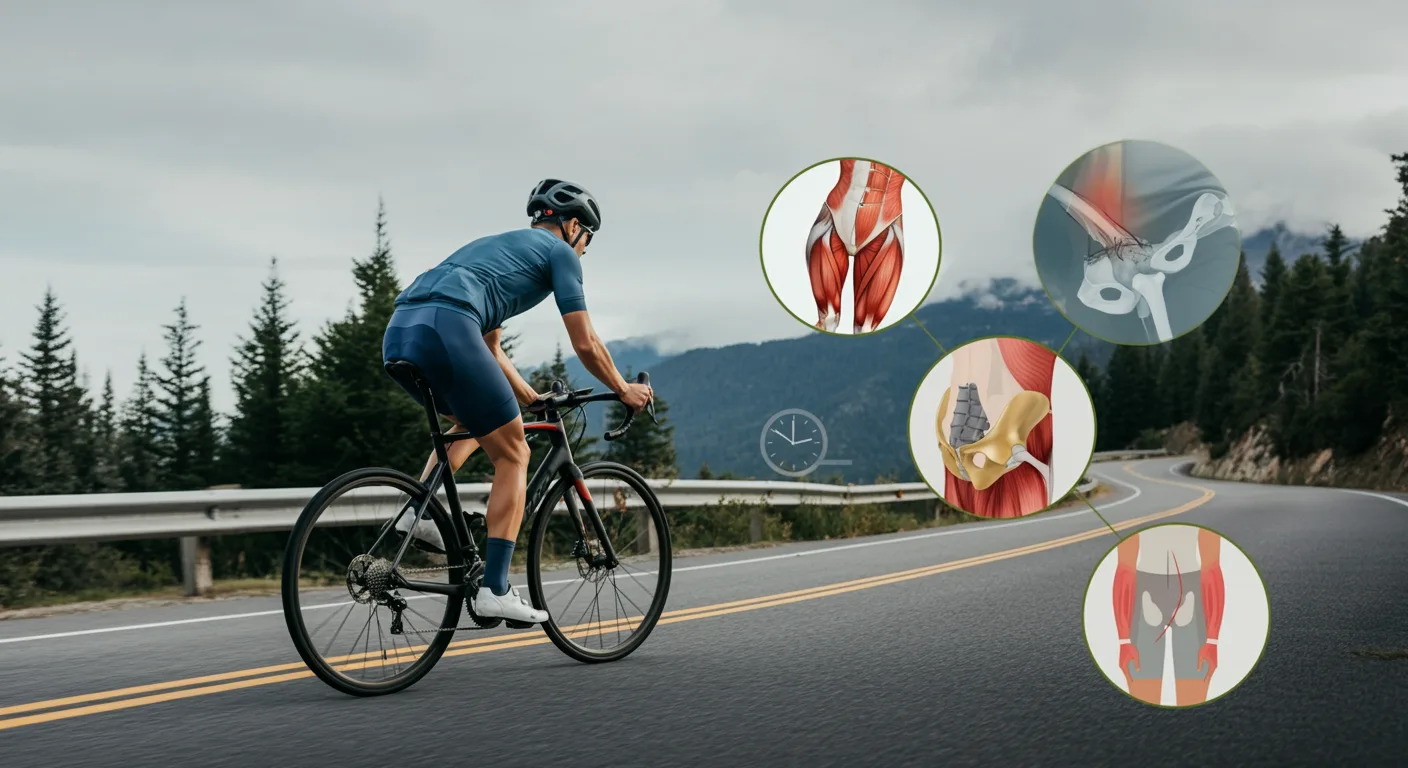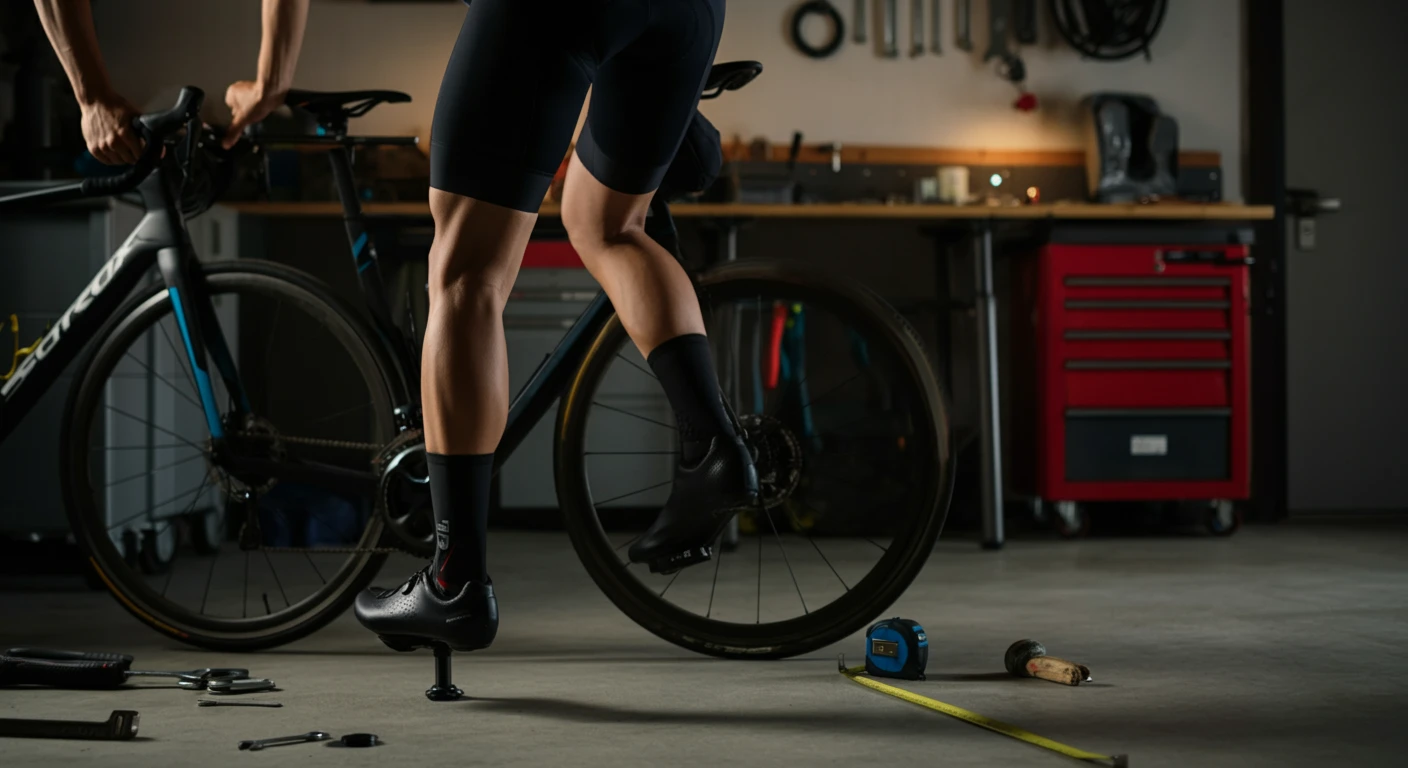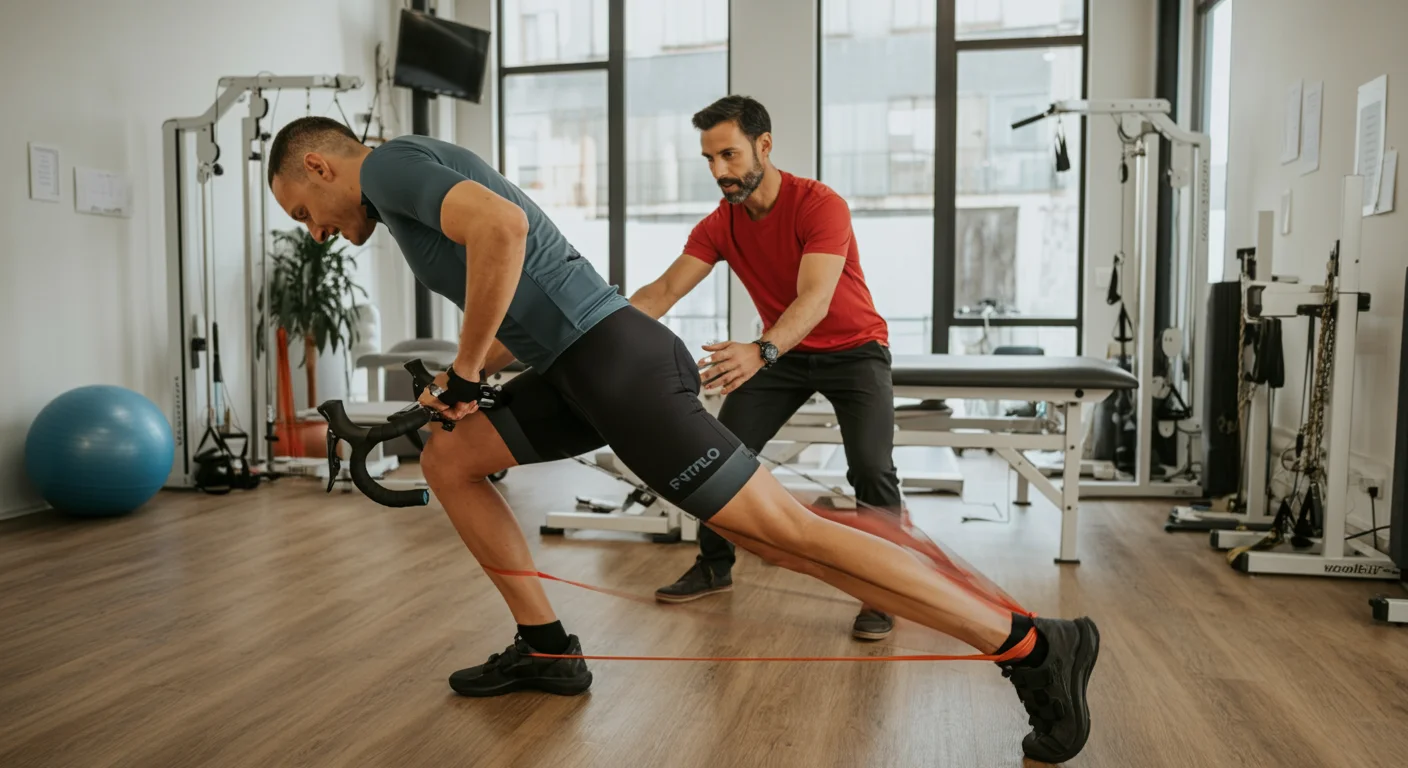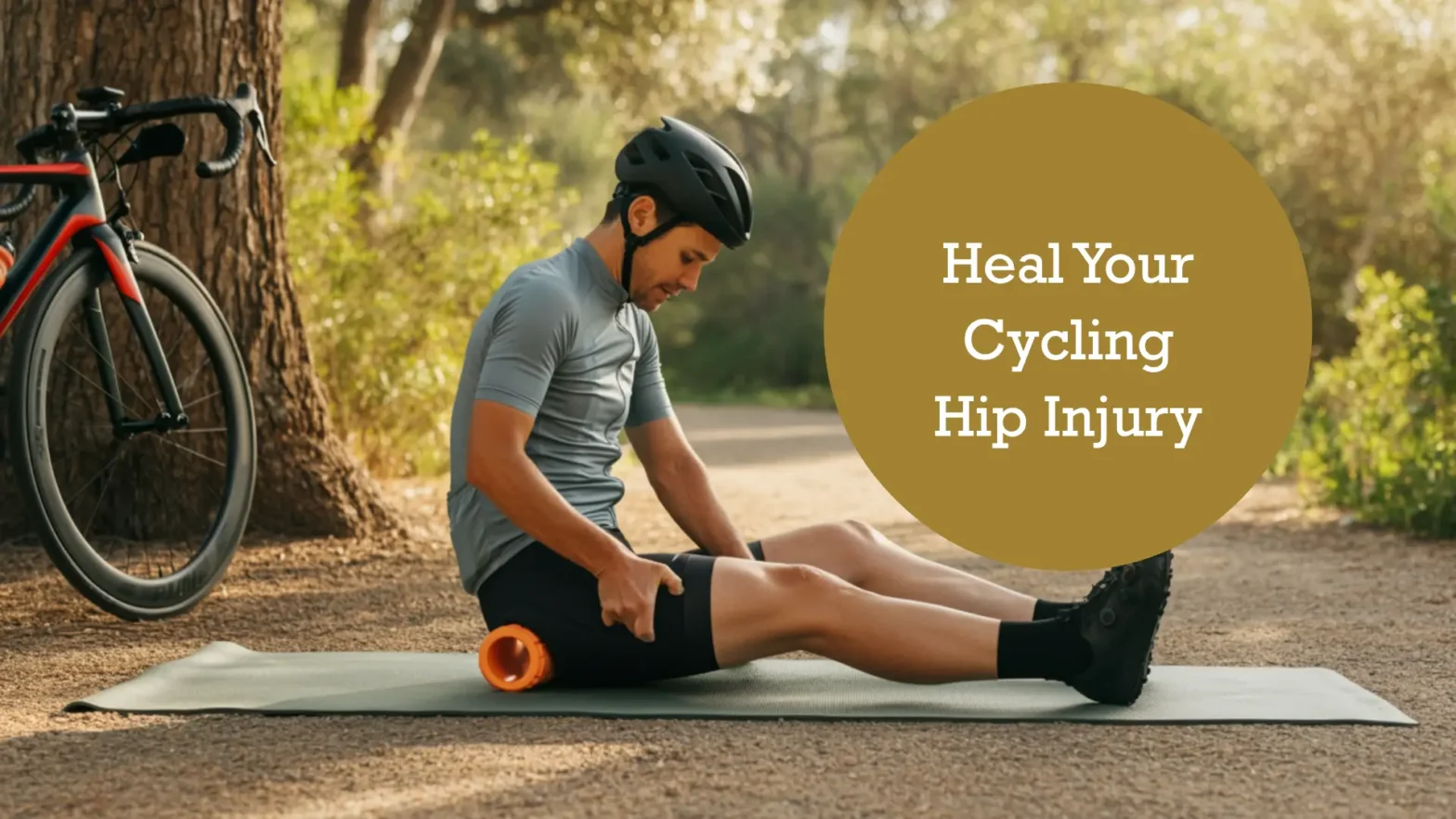The two most common hip injuries are piriformis syndrome and bursitis. A small muscle called the piriformis rotates the leg outward. Over-training, pushing excessive gears, and muscular imbalance are the leading causes of cycling hip injuries.
Regular massage or foam rolling can maintain the gluteal and hip muscles. Bursitis is an inflammatory injury that usually requires a period off the bike, followed by a gradual return to biking once it is no longer painful. It is essential to address the muscle imbalances underlying the injury.
In this blog post, we’ll take a closer look at cycling hip injury’s common causes and tips on how to treat it effectively.
Cycling Hip Injury: 4 Major Causes You Must Know

Cycling is a good way for people to keep their hips in shape and strengthen their leg and hip muscles. But sometimes, poor bike fit has bad effects and leads to hip injuries. Various factors can contribute to hip injuries, including overuse, trauma, and muscle imbalances. We’ll discuss each factor in more detail.
Poor Bike Fit
The most common cause of hip injuries in cyclists is poor bike fit. When your bike is not fitted correctly, it can pressure your hips, resulting in pain or injury. Some signs of poor bike fit include:
- Knee pain.
- Lower back pain.
- Hip pain.
- Numbness or tingling in the hands or feet.
A properly fitted bike can prevent hip injuries caused by poor bike fit. You can do this by working with a bike fitter who can ensure your bicycle fits you correctly.
Overuse
Hips may hurt after cycling because of overuse. When you cycle for extended periods, it can strain your hips, causing pain or injury. Some signs of overuse include:
- Deep ache in the hip area.
- Discomfort increases with activity.
- Difficulty or pain when moving the leg or hip joint.
You need to build up your cycling endurance gradually to avoid overuse. You should also take frequent breaks to allow your hips to rest and recover.
Trauma
Trauma is another cause of hip injuries among cyclists. A fall or collision with an object while cycling can cause hip injuries such as fractures or dislocations. Some signs of trauma include:
- Severe pain in the hip area.
- Swelling or bruising.
- Difficulty moving a leg or hip.
To prevent hip injuries caused by trauma, wearing protective gear, such as padded clothing, is essential while cycling.
Muscle Imbalances
Muscle imbalances can also cause hip injuries in cyclists. When one group of muscles is more potent than another, it can put pressure on the hips and cause pain. Some signs of muscle imbalances include:
- Uneven leg length.
- Tightness or weakness in the hip area.
- Difficulty balancing.
Cycling routines should include strength training exercises to prevent hip injuries due to muscle imbalances. You should also stretch regularly to improve flexibility in the hip area.
Cycling Hip Injury: Types & Treatment
Hip injuries are common in cycling due to the repetitive nature of the activity. Overuse, saddle height, and lack of flexibility can all contribute to sore hips after cycling. Here are a few types of cycling hip injuries and the various treatments.
Muscle Strains
A strain occurs when muscles are stretched too far or torn by overuse. This type of injury is common among cyclists as they pedal for extended periods. Here are some causes, symptoms, and treatments for muscle strains:
Causes:
- Overexertion while cycling.
- Poor bike fit.
- Refrain from warming up or stretching before cycling.
Symptoms:
- The hips or groin are in pain.
- Stiffness.
- Swelling.
- Bruising.
Treatment:
- Rest and avoid cycling until the pain subsides.
- Ice and elevate the affected area.
- Stretching and physical therapy.
- Anti-inflammatory medication.
Labral Tears in Cycling

A labrum is a ring of cartilage that lines the hip socket and cushions the bones. A labral tear is a shared cycling hip injury when this cartilage is damaged. A few causes, symptoms, and treatments for labral tears:
Causes:
- Repeated hip flexion and extension while cycling.
- Saddle pressure on the hip.
- Trauma or fall while cycling.
Symptoms:
- The hip or groin area is painful.
- Decreased range of motion.
- Hip catching or clicking.
Treatment:
- Until the pain subsides, avoid cycling.
- Physical therapy to strengthen the hip muscles.
- Anti-inflammatory medication.
- Surgery in severe cases.
Hip Impingement
Hip impingement occurs when bones in the hip joint rub against each other, damaging cartilage.
Cycling is possible if you have hip impingement and use the right bike. Injury of this type is common among cyclists who spend prolonged periods seated. Hip impingement causes, symptoms, and treatments include:
Causes:
- Cycling with hip flexion and extension.
- Poor bike fit.
- Tight hip muscles.
Symptoms:
- Pain in the hip or groin area.
- Decreased range of motion.
- Stiffness.
- Clicking or locking of the hip joint.
Treatment:
- Wait to cycle until the pain subsides.
- Anti-inflammatory medication.
- Physical therapy to stretch and strengthen hip muscles.
- Surgery in severe cases.
Hip Pain on One Side
Hip pain, on the other hand, is a common complaint among cyclists. It can result from many factors, from overuse injuries to structural abnormalities. We will provide a comprehensive guide to cycling hip pain and treatment options.
Causes
There are several causes of hip pain on one side in cyclists. Some of the most common causes include:
- Overuse injuries: Hip pain on one side can be caused by overuse injuries, which occur when repeated stress is placed on the joint. Inflammation and pain can result from this strain on the hip joint.
- Structural abnormalities: Structural abnormalities, such as femoral anteversion or hip dysplasia, can cause hip pain on one side.
- Muscle strains: One-sided hip pain can be caused by muscle strains, such as the gluteus medius or piriformis muscles.
Symptoms
Hip pain can have a variety of symptoms depending on the underlying cause. Some of the most common symptoms include:
- Pain in the hip joint, groin, or thigh.
- Stiffness and decreased range of motion.
- Swelling or tenderness in the affected area.
- Weakness in the hip muscles.
Treatment
The treatment options for cyclists with hip pain on one side depend on the underlying cause. Some of the most common treatment options include:
- Rest: Rest is essential for reducing hip pain and inflammation.
- Physical therapy: Physical therapy can strengthen hip muscles and improve the range of motion.
- Medications: You can take ibuprofen and acetaminophen for pain.
- Injections: Corticosteroid injections can reduce hip joint pain and inflammation.
- Surgery: For severe cases of hip dysplasia, surgery may be required.
Impact of Seat Height
As a cycling enthusiast, you want to ensure that you take good care of your body, especially your hip joints. Cycling hip injuries are common among cyclists, and they can be painful and restrict your ability to cycle. Among the factors that contribute to hip injuries is the seat height. We will discuss how seat height affects hip pain, how to find the ideal seat height and the benefits of proper seat height.
How Seat Height Affects
Hip pain is one of the most common complaints among cyclists, and seat height is one of the most significant contributors. Here are some ways that seat height affects hip pain:
- If the seat height is too high, you must pedal with your toes, which can cause pain in your Achilles tendon, the calf muscles, and the bottom of your foot.
- When the seat height is too low, your knees will bend too much, causing tightness and fatigue in your hip and thigh muscles and potentially causing injury.
- When your seat height is too high or low, it can create pressure points in your hip joints, leading to inflammation and pain.
- A poor saddle height Piriformis syndrome occurs after an excessive spasm of the piriformis muscle, causing numbness, tingling, and pain down the leg and into the foot (similar to sciatic pain).
Finding the Ideal Seat Height

Finding the ideal seat height can be difficult and time-consuming but worthwhile. Here are some steps to help you find the perfect seat height:
- Put on your cycling shoes and sit on your bike. Put your foot on the pedal, and make sure your leg is straight at the bottom of the stride.
- Adjust your seat height until your leg is almost fully extended, bending your knee. Your hips should not rock side to side when you pedal.
- Take a short ride and pay attention to how you feel. If your hips feel tight or painful, adjust the seat height accordingly.
Benefits
Having the proper seat height can benefit your cycling experience in many ways. Here are some advantages of having the right seat height:
- It reduces your risk of hip injuries, which can limit your cycling ability.
- It helps you pedal more efficiently, allowing you to ride faster and longer.
- The exercise reduces stress and improves posture in the lower back and neck.
- It enhances your comfort on the bike, allowing you to enjoy your rides more.
Outer Hip Pain in Cycling
If you are a cyclist experiencing outer hip pain, it is essential to understand the cause and take the necessary steps to resolve it.
Causes
- The iliotibial band syndrome (ITBS).
- Tight hip muscles, particularly the hip abductors.
- Incorrect bike fit or riding position.
Symptoms
- Pain on the outside of the hip, typically worsened by cycling.
- Pain that may radiate down the outside of the leg.
- Swelling and tenderness around the hip joint.
Treatment options
- Rest and ice.
- Stretching exercises, such as the pigeon pose.
- Physiotherapy or massage therapy.
- Adjusting your bike fit or position.
- Anti-inflammatory medication.
Front Hip Pain From Cycling
Front hip pain is common among cyclists after cycling, especially those who engage in long rides or intense training sessions. Pain can be sharp, dull, or achy, interfering with biking or daily activities.
Causes
- Stress fractures or other bone injuries.
- Soft tissue injuries, such as hip flexor strains.
- Nerve irritation.
Symptoms
- Pain in the front of the hip, particularly during or after cycling.
- The pain may be felt down the thigh or groin area.
- Pain when walking or difficulty lifting the leg.
Treatment Options
- Rest and ice.
- Physiotherapy or massage therapy.
- Anti-inflammatory medication.
- Fitting or adjusting your bike.
- In severe cases, surgery may be required.
Cycling Hip Injury: Management
Cycling can also cause hip injuries, which can cause discomfort and impact a cyclist’s performance. Proper management of cycling-related hip injuries is crucial to ensure a speedy recovery.
Rest and Recovery
One of the first steps in managing cycling-related hip injuries is to rest and allow the injured hip to recover. Depending on the severity of the injury, this may involve reducing or altogether avoiding cycling activities. Rest and recovery time can prevent further damage to the hip and promote healing.
Physical Therapy

Physical therapy is commonly used to treat hip injuries in cyclists. It involves exercises and activities to improve strength, flexibility, and mobility in the hip joint. A physical therapist can also reduce pain and swelling in the affected area.
Medications
A nonsteroidal anti-inflammatory drug (NSAID) may be prescribed to manage hip pain and inflammation. Following a healthcare professional’s advice before taking any medication is essential to avoid potential side effects.
Surgery
Surgery may be necessary for severe cases of hip injury. This may involve procedures such as arthroscopy or hip replacement. Surgical intervention is usually a last resort when other treatment options have been exhausted.
Recovery Process
The recovery process of cycling-related hip injuries varies depending on the type and severity of the injury. Minor injuries like strains and sprains may require physical therapy and rest. Fractures and dislocations may require longer recovery times and may involve surgery.
Conclusion
Cycling is undoubtedly healthy and rewarding, but it can come with injuries like any other physical activity. Hip injuries are one of the most common ones that cyclists face, and it can be a painful experience if left untreated.
Taking necessary precautions like stretching, using proper cycling form, and investing in quality gear can significantly reduce your risk of developing a hip injury. If you experience pain or discomfort, seeking medical attention and prompt treatment is always advisable. With proper care, you can return to your bike and enjoy the benefits of cycling again.
FAQs
How Does A Bike Fall Cause A Hematoma On The Hip?
A hematoma on the hip can occur after a bike fall. The impact inflicts trauma on the soft tissues and blood vessels in the hip region, causing internal bleeding. The hematoma forms beneath the skin. The intensity of the hematoma can vary based on the fall’s force and the cyclist’s landing surface.
How Bad Is Cycling for Tight Hips?
Regularly riding your bike often involves spending much time in a hunched forward position, placing your hip flexors in a compressed state. Regrettably, this can increase the likelihood of experiencing tightness in your hips, leading to limitations in your pedal stroke, decreased speed, and potential discomfort.
Does Cycling Cause Trochanteric Bursitis?
Cycling alone does not directly lead to trochanteric bursitis. Factors like improper bike fit, sudden or excessive intensity changes in cycling, or poor cycling technique can contribute to developing or worsening trochanteric bursitis.
Does Spinning Cause Hip Pain?
Spinning, also known as indoor cycling, may lead to hip pain, particularly when the bike isn’t correctly tailored to your body or if you overexert during the session. Excessive effort or improper posture in spinning classes can worsen hip discomfort.


